How To Tell If You Need A New Roof
A Guide To DIY Roof Inspection & 14 Signs You Need A New Roof
As a homeowner of an old or aging house, you are probably wondering how to tell if you need a new roof.
You likely also want to know when your roof needs to be replaced and how often your roof should be replaced. Finding answers to these questions can be tricky sometimes and, often, the answers you need aren’t all in one place.
We want to change that.
In this “how to tell if you need a new roof” guide, we will cover three main topics:
How to perform an interior roof check
How to perform an exterior roof check
What to do if you identify roof damage
Part 1: Perform An Interior Roof Check
The first and easiest way to evaluate your roof’s condition is to grab a flashlight and head up to your attic. Make sure you grab a flashlight with a bright beam so you don’t miss any damage and always be sure to be safe as you perform these kinds of inspections.
Once you are in your attic, see if you can identify one (or several) of these 4 signs that you need a new roof:
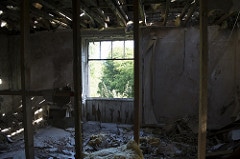
1) Daylight Through The Roof Boards
Before you turn your flashlight on, see if you can identify any streams of light coming through cracks or holes in your roof. If you do spot any light coming through your roof, repair or replace your roof immediately. If light is getting through your roof, then water is getting through your roof.
2) Dark Streaks & Stains
This one is also extremely easy to identify. If you see dark stains or dark streaks on the underside of your roof or running down the walls from the base of your roof, then you’re roof is likely leaking and moisture is damaging both your roof, as well as your home’s interior structure.
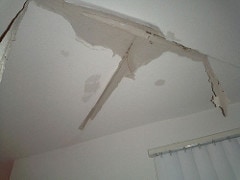

3) Sagging Areas
In the same way that water will make a piece of cardboard soggy and weak, water can also make the structure of your roof begin to sag. If you identify sagging areas in your roof, use your hand or a broom to lightly prod at the sagging spot. If the spot feels soft and wet or bends easily with the prod of your broom, you know you have moisture damage.
4) Leaks & Water Damage
In addition to checking for dark streaks and sagging areas, make sure to look for any obvious signs of water leaking or rotting your roof on the inside. If you see any clear signs of water damage, you should contact someone to inspect your roof immediately.

Part 2: Perform An Exterior Roof Check
Once you have performed an interior roof check, it is also a good idea to take a look at your roof from the outside. Interior roof checks are essential because they will help you identify roof damage that has already reached the interior of your roofing structure.
Exterior roof checks, however, are money-savers because they can help you to identify “roof damage” before it actually becomes real roof damage.
(Note: An exterior roof check is a great thing for homeowners to perform regularly, when they are able-bodied and have the right equipment. However, exterior roof checks are dangerous. If you are physically challenged or do not possess the right equipment, please consider calling a professional to perform a roof inspection—most do it for FREE!)
Once you are in your attic, see if you can identify one (or several) of these 10 signs that you need a new roof:

1) Dark Streaks & Stains
In the same way that you performed the interior roof check, look for any noticeable dark streaks or dark stains that would indicate water damage. If it looks like damage, it probably is damage.
2) Leaks & Water Damage
Obvious leaks, dark stains, sagging spots, rotting tiles—these are all clear signs of water damage to your roof. Do not ignore these types of damages, no matter how small they may seem because they will only continue to get worse.

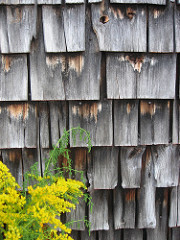
3) Rotting
Rotting is common for wooden and asphalt roofs. Look for signs of rotting and decaying. Telltale signs of this type of damage would be rotten tiles, missing & broken tiles, or moldy buildup on a group of tiles.
4) Moss & Algae
Fortunately, algae growth and buildup is not normally a sign that you need to repair or replace your roof. Rather, moss is more of just an eyesore to your roof and one that is extremely common in humid geographic regions.
Quick Fix Tip: Grab your garden house and spray it forcefully. This should remove most of it. If you still need some extra help removing it, you could use a weak solution of hydrogen peroxide, mixed with water to “burn” away any persistent algae.

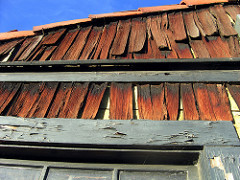
5) Decaying Shingles
While rot is common to wooden and asphalt roofs, decay & cracking are common to shingle roofs. Look for spots with missing shingles, as well as spots with shingles that are cracking, curling or buckling (i.e. out of place).
6) Shingle Granules In The Gutter
Another easy way to identify damage to your shingles is to look for particles and pieces of your shingles in your gutter. If you find pieces of your shingles washed down to your gutter, then your roof could be susceptible to greater water damage and roof decay.
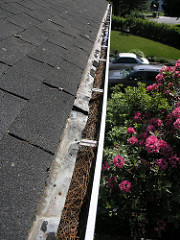
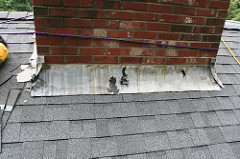
7) Damaged Chimney & Roof Flashing
Flashing is most commonly found around the base of your chimney. If your flashing is made of roof cement or tar, then it is more vulnerable to water damage. Consider replacing it with a more durable metal flashing system.
8) Roof Valley
“Roof valley” is the spot where two parts of your roof (sloping down) meet each other. This is one of the most common areas for roof damage because snow and rain flow through valleys into gutters.

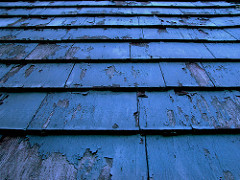
9) Roof Age > 20 Years
One easy way to be sure you need a roof replacement is if your roof is older than 20 years old. If you’ve lived in your home for a long time you may know your roof’s age. If not, keep an eye out for your neighbor’s getting roof replacements.
10) Shoddy Workmanship
Most of the time it doesn’t take a professional to spot shoddy workmanship. If your roof is covered in patches, or tiles and shingles seem to fit together awkwardly, then you can be fairly certain that your roof isn’t in great shape.
Also, if you happen to notice multiple layers on your roof while you are performing this exterior roof check, you know that corners were cut on the previous roof replacement.
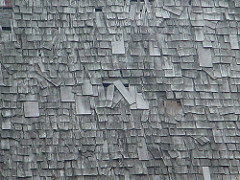
Part 3: What To Do If You Identify Roof Damage
After you have finished your interior and exterior roof checks, make note of any damages you noticed during your inspection. Then do your research and call a professional roofing inspector to come evaluate your roof’s condition.
These inspections are almost always FREE, so be wary of any company that doesn’t offer a free roof inspection.
When the roof inspector arrives, inform them of any damage you saw. They will be able to validate the damage you indicate, as well as look for any damages you may have missed.
Don’t wait months or even years, as the damage on your roof gets worse and worse (and more expensive!). Perform your damage inspections today and call a professional roof inspector if you need help.
Conclusion
If you’re in need of a professional service, inspection, or estimate for roof damage, get in touch with American Dream Restoration. We offer comprehensive repair and inspection services for every kind of roof, and we can help you repair and restore your roof quickly and efficiently. Call us today!
